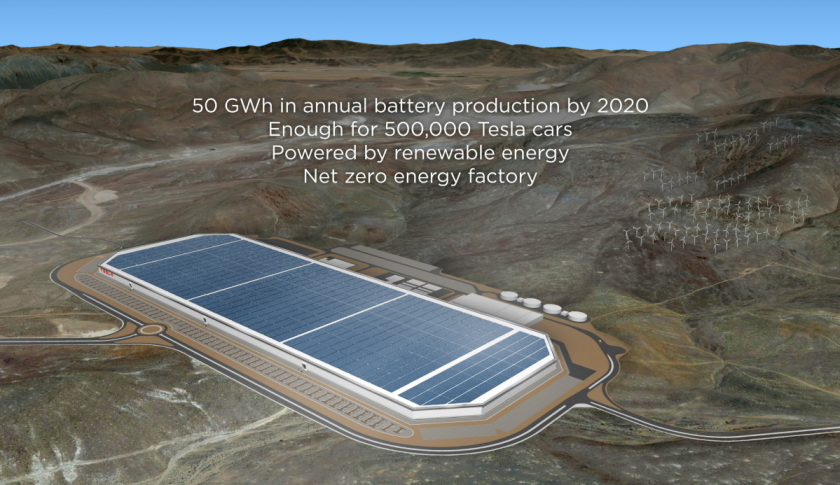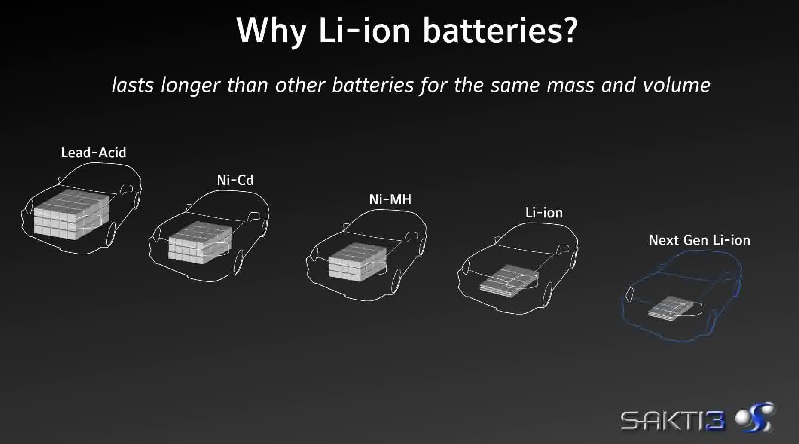News
Solid State Battery Technology, a Tesla Gigafactory Killer?

With 2014 coming to an end, automotive battery news has been trickling out and solid state battery technology appears, again.
In early December, Volkswagen acquired a small equity stake in Stanford-based QuantumScape and Daimler recently announced that its lithium production output will be larger in 2015 due to a new battery plant in Kamenz, Germany, said to be ready by mid-2015.
The VW news keeps the the solid state battery thread for 2014 going as scientists point to its reported improved energy density over lithium-ion technology. A solid state battery does not use a liquid electrolyte like a lithium battery does and, in theory, a solid electrolyte can hold more energy. Yes, please.
Getting rid of an electrolyte—no liquid—can also improve battery safety and reduce costs due to less cooling electronics and micro-controllers needed for pack management, thus reducing weight too, according to Harvard Business Review.
What about downsides to this technology? A solid-state battery has electrical contacts or, electrodes, that are applied to a solid electrolyte—similar to a thin-film solar panel process—and if there’s a lack of uniformity in this process, it can cause short circuits. However, this type of manufacturing application has been done in the thin-film solar area and these obstacles should be easy to overcome.
Earlier this year, Scientific American did a profile on Ann Arbor, Michigan-based Sakti3 and their push with solid-state battery technology and move closer to the “god” battery.
Ann Marie Sastry, co-founder and CEO of the company, said, “that the company’s prototype solid-state lithium battery cells have reached a record energy density of 1,143 Watt-hours per liter—more than double the energy density of today’s best lithium-ion batteries.”
However, as Elon Musk said in the most recent Tesla earnings call,
“Talk is super cheap, the battery industry has to have more BS in it than any industry I’ve ever encountered. It’s insane.”
So is this technology an immediate challenger to Tesla Motors’ Gigafactory strategy? Will this battery technology get ahead of Tesla, due its battery equipment investment at the Gigafactory being close to complete and, thus, no turning back?
No and the reason is battery development takes a lot of time and these recent statements by Sakti3 in the Scientific American article bear this out.
Sakti3 says it’s close to the end of lab work—custom prototype manufacturing line—but then the next step is on to small scale production and this could take a another year or two of testing before you hit mass production.
That rules out GM going with this type of battery for their mass-produced battery electric vehicle for 2016 or 2017. Plus, Sakti3 mentioned its first aim is small-scale electronics and smartphones.
More importantly, JB Straubel and Tesla Motors aren’t looking for the God battery for 2017. Everyone seems to be looking for this right chemistry to scale with at this point. Granted, these are big automakers that could scale quickly as long their company culture is rowing in the same direction.
Tesla has their battery composition set and plan to cut 30 percent or more of costs out of their current battery price, which stands anywhere from $260 to maybe $220 kWh. Take the high end and with the cost savings, the battery pack is at $185 kWh, approximately.
That’s just over $10,000 for a battery pack for a 55kWh battery pack—assumption 30% battery cost reduction translates to battery pack. Also, my assumption above is that a Gen 3 car will be smaller and could get 220 miles with a smaller battery pack.
The rub for me is that the roadmap is in place for Tesla Motors battery chemistry and this should get them to a mass-market electric vehicle, first. Maybe other automakers are close to a new chemistry, but automotive testing and applications take time.
In the end, I’m all for the god battery sooner rather than later but Tesla Motors just isn’t waiting for it.

Elon Musk
Elon Musk’s X will start using a Tesla-like software update strategy
The initiative seems designed to accelerate updates to the social media platform, while maintaining maximum transparency.

Elon Musk’s social media platform X will adopt a Tesla-esque approach to software updates for its algorithm.
The initiative seems designed to accelerate updates to the social media platform, while maintaining maximum transparency.
X’s updates to its updates
As per Musk in a post on X, the social media company will be making a new algorithm to determine what organic and advertising posts are recommended to users. These updates would then be repeated every four weeks.
“We will make the new 𝕏 algorithm, including all code used to determine what organic and advertising posts are recommended to users, open source in 7 days. This will be repeated every 4 weeks, with comprehensive developer notes, to help you understand what changed,” Musk wrote in his post.
The initiative somewhat mirrors Tesla’s over-the-air update model, where vehicle software is regularly refined and pushed to users with detailed release notes. This should allow users to better understand the details of X’s every update and foster a healthy feedback loop for the social media platform.
xAI and X
X, formerly Twitter, has been acquired by Elon Musk’s artificial intelligence startup, xAI last year. Since then, xAI has seen a rapid rise in valuation. Following the company’s the company’s upsized $20 billion Series E funding round, estimates now suggest that xAI is worth tens about $230 to $235 billion. That’s several times larger than Tesla when Elon Musk received his controversial 2018 CEO Performance Award.
As per xAI, the Series E funding round attracted a diverse group of investors, including Valor Equity Partners, Stepstone Group, Fidelity Management & Research Company, Qatar Investment Authority, MGX, and Baron Capital Group, among others. Strategic partners NVIDIA and Cisco Investments also continued support for building the world’s largest GPU clusters.
News
Tesla FSD Supervised wins MotorTrend’s Best Driver Assistance Award
The decision marks a notable reversal for the publication from prior years, with judges citing major real-world improvements that pushed Tesla’s latest FSD software ahead of every competing ADAS system.

Tesla’s Full Self-Driving (Supervised) system has been named the best driver-assistance technology on the market, earning top honors at the 2026 MotorTrend Best Tech Awards.
The decision marks a notable reversal for the publication from prior years, with judges citing major real-world improvements that pushed Tesla’s latest FSD software ahead of every competing ADAS system. And it wasn’t even close.
MotorTrend reverses course
MotorTrend awarded Tesla FSD (Supervised) its 2026 Best Tech Driver Assistance title after extensive testing of the latest v14 software. The publication acknowledged that it had previously criticized earlier versions of FSD for erratic behavior and near-miss incidents, ultimately favoring rivals such as GM’s Super Cruise in earlier evaluations.
According to MotorTrend, the newest iteration of FSD resolved many of those shortcomings. Testers said v14 showed far smoother behavior in complex urban scenarios, including unprotected left turns, traffic circles, emergency vehicles, and dense city streets. While the system still requires constant driver supervision, judges concluded that no other advanced driver-assistance system currently matches its breadth of capability.
Unlike rival systems that rely on combinations of cameras, radar, lidar, and mapped highways, Tesla’s FSD operates using a camera-only approach and is capable of driving on city streets, rural roads, and freeways. MotorTrend stated that pure utility, the ability to handle nearly all road types, ultimately separated FSD from competitors like Ford BlueCruise, GM Super Cruise, and BMW’s Highway Assistant.
High cost and high capability
MotorTrend also addressed FSD’s pricing, which remains significantly higher than rival systems. Tesla currently charges $8,000 for a one-time purchase or $99 per month for a subscription, compared with far lower upfront and subscription costs from other automakers. The publication noted that the premium is justified given FSD’s unmatched scope and continuous software evolution.
Safety remained a central focus of the evaluation. While testers reported collision-free operation over thousands of miles, they noted ongoing concerns around FSD’s configurable driving modes, including options that allow aggressive driving and speeds beyond posted limits. MotorTrend emphasized that, like all Level 2 systems, FSD still depends on a fully attentive human driver at all times.
Despite those caveats, the publication concluded that Tesla’s rapid software progress fundamentally reshaped the competitive landscape. For drivers seeking the most capable hands-on driver-assistance system available today, MotorTrend concluded Tesla FSD (Supervised) now stands alone at the top.
News
Elon Musk’s Grokipedia surges to 5.6M articles, almost 79% of English Wikipedia
The explosive growth marks a major milestone for the AI-powered online encyclopedia, which was launched by Elon Musk’s xAI just months ago.

Elon Musk’s Grokipedia has grown to an impressive 5,615,201 articles as of today, closing in on 79% of the English Wikipedia’s current total of 7,119,376 articles.
The explosive growth marks a major milestone for the AI-powered online encyclopedia, which was launched by Elon Musk’s xAI just months ago. Needless to say, it would only be a matter of time before Grokipedia exceeds English Wikipedia in sheer volume.
Grokipedia’s rapid growth
xAI’s vision for Grokipedia emphasizes neutrality, while Grok’s reasoning capabilities allow for fast drafting and fact-checking. When Elon Musk announced the initiative in late September 2025, he noted that Grokipedia would be an improvement to Wikipedia because it would be designed to avoid bias.
At the time, Musk noted that Grokipedia “is a necessary step towards the xAI goal of understanding the Universe.”
Grokipedia was launched in late October, and while xAI was careful to list it only as Version 0.1 at the time, the online encyclopedia immediately earned praise. Wikipedia co-founder Larry Sanger highlighted the project’s innovative approach, noting how it leverages AI to fill knowledge gaps and enable rapid updates. Netizens also observed how Grokipedia tends to present articles in a more objective manner compared to Wikipedia, which is edited by humans.
Elon Musk’s ambitious plans
With 5,615,201 total articles, Grokipedia has now grown to almost 79% of English Wikipedia’s article base. This is incredibly quick, though Grokipedia remains text-only for now. xAI, for its part, has now updated the online encyclopedia’s iteration to v0.2.
Elon Musk has shared bold ideas for Grokipedia, including sending a record of the entire knowledge base to space as part of xAI’s mission to preserve and expand human understanding. At some point, Musk stated that Grokipedia will be renamed to Encyclopedia Galactica, and it will be sent to the cosmos.
“When Grokipedia is good enough (long way to go), we will change the name to Encyclopedia Galactica. It will be an open source distillation of all knowledge, including audio, images and video. Join xAI to help build the sci-fi version of the Library of Alexandria!” Musk wrote, adding in a later post that “Copies will be etched in stone and sent to the Moon, Mars and beyond. This time, it will not be lost.”









